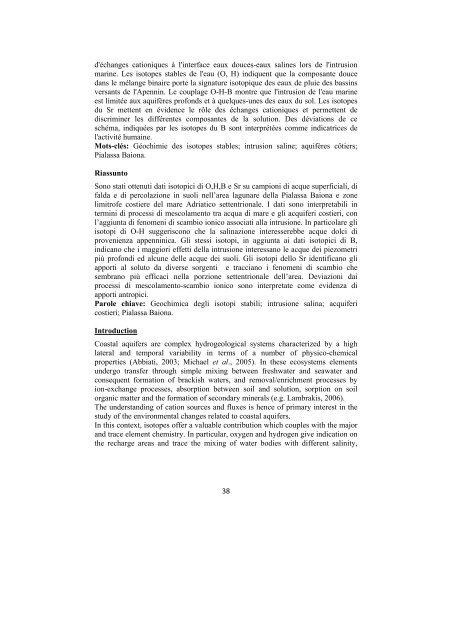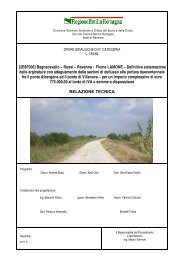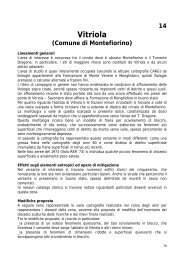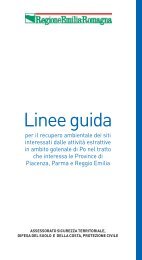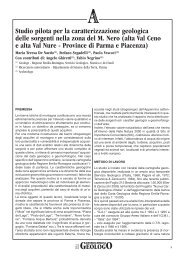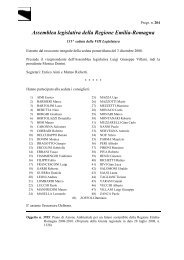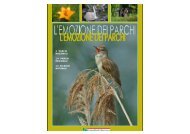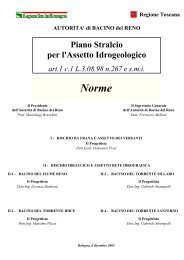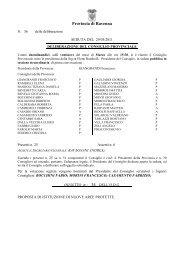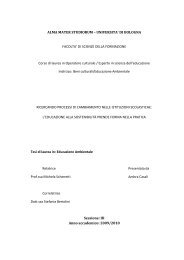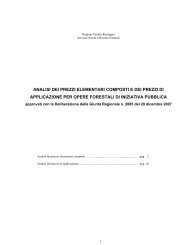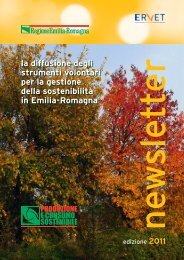air, water and soil quality qualité - ER Ambiente - Regione Emilia ...
air, water and soil quality qualité - ER Ambiente - Regione Emilia ...
air, water and soil quality qualité - ER Ambiente - Regione Emilia ...
Create successful ePaper yourself
Turn your PDF publications into a flip-book with our unique Google optimized e-Paper software.
d'échanges cationiques à l'interface eaux douces-eaux salines lors de l'intrusion<br />
marine. Les isotopes stables de l'eau (O, H) indiquent que la composante douce<br />
dans le mélange bin<strong>air</strong>e porte la signature isotopique des eaux de pluie des bassins<br />
versants de l'Apennin. Le couplage O-H-B montre que l'intrusion de l'eau marine<br />
est limitée aux aquifères profonds et à quelques-unes des eaux du sol. Les isotopes<br />
du Sr mettent en évidence le rôle des échanges cationiques et permettent de<br />
discriminer les différentes composantes de la solution. Des déviations de ce<br />
schéma, indiquées par les isotopes du B sont interprétées comme indicatrices de<br />
l'activité humaine.<br />
Mots-clés: Géochimie des isotopes stables; intrusion saline; aquifères côtiers;<br />
Pialassa Baiona.<br />
Riassunto<br />
Sono stati ottenuti dati isotopici di O,H,B e Sr su campioni di acque superficiali, di<br />
falda e di percolazione in suoli nell’area lagunare della Pialassa Baiona e zone<br />
limitrofe costiere del mare Adriatico settentrionale. I dati sono interpretabili in<br />
termini di processi di mescolamento tra acqua di mare e gli acquiferi costieri, con<br />
l’aggiunta di fenomeni di scambio ionico associati alla intrusione. In particolare gli<br />
isotopi di O-H suggeriscono che la salinazione interesserebbe acque dolci di<br />
provenienza appenninica. Gli stessi isotopi, in aggiunta ai dati isotopici di B,<br />
indicano che i maggiori effetti della intrusione interessano le acque dei piezometri<br />
più profondi ed alcune delle acque dei suoli. Gli isotopi dello Sr identificano gli<br />
apporti al soluto da diverse sorgenti e tracciano i fenomeni di scambio che<br />
sembrano più efficaci nella porzione settentrionale dell’area. Deviazioni dai<br />
processi di mescolamento-scambio ionico sono interpretate come evidenza di<br />
apporti antropici.<br />
Parole chiave: Geochimica degli isotopi stabili; intrusione salina; acquiferi<br />
costieri; Pialassa Baiona.<br />
Introduction<br />
Coastal aquifers are complex hydrogeological systems characterized by a high<br />
lateral <strong>and</strong> temporal variability in terms of a number of physico-chemical<br />
properties (Abbiati, 2003; Michael et al., 2005). In these ecosystems elements<br />
undergo transfer through simple mixing between fresh<strong>water</strong> <strong>and</strong> sea<strong>water</strong> <strong>and</strong><br />
consequent formation of brackish <strong>water</strong>s, <strong>and</strong> removal/enrichment processes by<br />
ion-exchange processes, absorption between <strong>soil</strong> <strong>and</strong> solution, sorption on <strong>soil</strong><br />
organic matter <strong>and</strong> the formation of secondary minerals (e.g. Lambrakis, 2006).<br />
The underst<strong>and</strong>ing of cation sources <strong>and</strong> fluxes is hence of primary interest in the<br />
study of the environmental changes related to coastal aquifers.<br />
In this context, isotopes offer a valuable contribution which couples with the major<br />
<strong>and</strong> trace element chemistry. In particular, oxygen <strong>and</strong> hydrogen give indication on<br />
the recharge areas <strong>and</strong> trace the mixing of <strong>water</strong> bodies with different salinity,<br />
<br />
38


